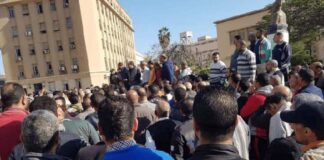Egypt’s “second day of rage” on May 27 showed that the revolution is far from over. Over a million people across Egypt rallied and Tahrir Square was once again packed.
An even bigger demonstration was held in Alexandria, Egypt’s second city, while mass rallies were held in Suez, Port Said, Mansoura and many other cities. While this day of action was smaller than the massive protests that brought down Mubarak, it was significant in a number of ways.
Firstly the protests directly targeted the Supreme Council of Armed Forces—the generals who took over from Mubarak—as part of the problem. Secondly they were organised by radical left networks in the face of stiff opposition from Egypt’s elite and the influential Muslim Brotherhood.
A vicious campaign of fear was run against the mobilisations in an attempt to isolate the left.
The military leaders warned of “suspicious elements” trying to “drive a wedge between the Egyptian people and its armed forces”.
Both the state and liberal media opposed the mobilisations and organisers were accused of wanting to create chaos.The billionaire co-founder of the liberal Free Egyptians Party, Naguib Sawiris, said security needed to be restored nationwide to help restart production. Multinational companies sent emails to employees warning them to avoid the rallies for safety reasons while the Muslim Brotherhood attacked the organisers as “counterrevolutionary”.
Dissatisfaction
But deep dissatisfaction with the pace of change motivated people to come onto the streets.
Of particular concern was the lack of action in making Mubarak and his cronies accountable for their crimes.
Mubarak had only been charged with theft and was still living a luxury resort at Sharm el-Sheikh. People felt that Mubarak and his henchmen—responsible for killing 846 protesters during the revolution—were being protected.
People were also unhappy with the continual use of brute force against demonstrators.
“At least 85 demonstrators who were detained on March 9 are still in Tora prison” writes the Egyptian Human Rights activist, Heba Morayef. “The military wants to intimidate people not to protest on the street; all of these guys were taken to the grounds of the Egyptian Museum and tortured—beaten, whipped, subjected to electric shocks from stun guns”.
This brutality is not uncommon. A demonstration in Tahrir Square on April 9 was attacked with clubs, tear gas and live ammunition.
Over 350 protesters were wounded after riot police attacked a demonstration with tear gas and live ammunition outside of the Israeli embassy on Al Nakba day.
Thousands of civilians have been dragged before military courts—a legacy of the Mubarak era—some sentenced to up to five years.
On the day before the protest four activists were arrested for handing out leaflets and detained for 12 hours.
Unions too continue to be hammered. In Al Fayyum the army broke up a three day sit-in by postal workers resulting in many casualties and two arrests. A leader of the transport workers union, Ali Fetouh, has been hauled before a military court to answer charges of “inciting strikes”.
Attempts to intimidate journalists continue with some being dragged before military courts to answer charges of “stirring public disorder”.
Demonstrators also condemend the haste with which the upcoming elections are being organised. This gives established political parties and those with resources an advantage and there were demands for a civilian administration to take over the transition to democracy.
They also called for a living minimum wage—given that 40 per cent of Egyptians live on wages below the international poverty line.
Only days before the military announced it was charging Mubarak with murder, and would partly open the Rafah border crossing into Gaza. These last minute concessions were an attempt to undercut the mobilisation. But for many it was too little too late.
Transition
Since the removal of Mubarak in February there has been a concerted campaign to convince people the revolution is over and e to trust the military to oversee an orderly transition to democracy.
While the military leaders claim they are friends of the revolution, their real agenda is to maintain as much of the power and privilege of the elite as possible.
Their strategy is to give just enough concessions to keep people off the streets and encourage people to focus on upcoming elections, while brutally attacking localised struggles.
Egypt’s “second day of rage” shows people are starting to see the military aren’t their friends and liberation depends on continuing the revolution. These ongoing struggles represent the hope for carrying the process forward into a socialist revolution, where workers take hold of the country’s wealth to address the poverty that still grips the majority of the population.
By Mark Gillespie




